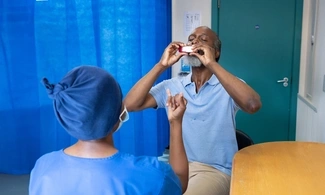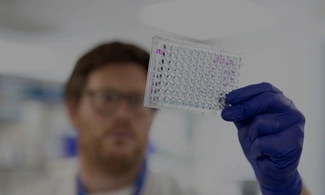Charity boss says it’s time to end the politics on pollution as new Asthma + Lung UK report shows £254m annual health and economic benefit of targeted scheme to help drivers make cleaner transport choices less damaging to people’s lungs
Two in five schools in the most polluted parts of England – Greater Manchester, the West Midlands, West Yorkshire and Liverpool – are within 500m of a busy and heavily polluted main road, according to new analysis by Asthma + Lung UK.1,2
The West Midlands and Greater Manchester dominate the list of most polluted primary and secondary schools in some of England’s worst pollution hotspots [table1]. A secondary school in Bolton which is 0.4 miles from a major A-road and where the modelled Nitrogen Dioxide (NO2) level, is 3.9 times the World Health Organization (WHO) limit, tops the list in our analysis.
With some of the busiest transport routes in the country running through these four cities, air pollution poses a risk for children in their daily lives. Whether it’s travelling to and from school, going to the shops or at play – children are exposed to air pollution across their communities, and research has long established there is no truly safe level of pollution.3 School catchment areas mean children usually go to school near where they live, and the closer they are to these heavily polluted routes, the higher the risk of even greater exposure as they travel to and from school.4,5
This is not about one school in one part of the country. Every day, an estimated 3.1 million children in England attend schools where the air surrounding them is over WHO’s recommended limits for Particulate Matter 2.5 (PM2.5).6,7 Asthma + Lung UK analysis also found that 99.8% of schools in England are in areas where outdoor modelled PM2.5 were above WHO levels.6,7,8 Both PM2.5 and NO2 are widely seen as the most harmful air pollutants to public health.7
The charity is now calling on the government to protect pupils from the associated health impacts of pollution by introducing a targeted support package to help people make cleaner transport choices. The range of greener travel options proposed include mobility credits towards public transport, an electric bike/scooter and helping drivers update their cars to electric vehicles with a £3,000 grant per eligible household. This scheme will help the poorest people in our society who are the most exposed to air pollution and those with long term health conditions access affordable cleaner travel options.
Toxic air is a public health emergency and contributes to up to 43,000 premature deaths per year.9 Evidence suggests that lungs continue to develop throughout childhood and into the teenage years. 10Lungs of younger people are especially vulnerable to the impacts of toxic air. Harmful air pollution particles can penetrate deeply into the lungs of children and have been shown to lead to stunted lung growth and worsen asthma in children.11,12
Our findings come as the latest data from the Department for Environment, Food & Rural Affairs (Defra) show Manchester is, for the second year running, the air pollution capital of the UK.13 Manchester was also Europe’s third most-polluted city in a recent WHO analysis.14 Defra’s figures show that where we’ve seen bold action and political leadership, like with the inner-London Ultra Low Emission Zone (ULEZ), we’re beginning to see improvements in air quality. In contrast, areas that are delaying air quality measures, such as a Clean Air Zone (CAZ), in Manchester, are falling behind.
Nationally, road transport is the single largest source of NO2, with more than 9 in 10 vehicles still running on petrol and diesel.15,16 Making it easier for people to switch to cleaner modes of transport not only protects our health - but also has big wins for our economic growth. That’s according to a new report by strategic environmental and engineering consultancy Ricardo plc out today, commissioned by the charity, looking at the economic and social impact of implementing our Cleaner Travel Access Fund (CTAF) in four of the most polluted regions in the country: Greater Manchester, West Midlands, West Yorkshire, and Liverpool.17
Ricardo’s modelling shows that the economic value of the health benefit that such a fund could deliver is £254m per year if implemented across England. The scheme is a 2.5-for-1 deal: for every £1 invested in the scheme by central government there is an economic payback of £2.50 for society. These tangible benefits include productivity gains from reducing the number of employee workdays missed and pupil absences from school due to the associated heath impacts of air pollution. NHS coffers benefit too: cutting patient care costs and providing greater value for money at a time when budgets are squeezed.
Greater Manchester would draw the greatest benefit from adopting this scheme compared to other regions, resulting in the largest modelled reductions of NO2, especially in the most deprived parts with the highest proportion of children.
Jo Pond, 41, is a mother of two who lives in Manchester, her asthma is triggered by the city’s high levels of pollution and has been a factor in her making the difficult decision to end her teaching career.
Jo said: "I've experienced the harmful effects of air pollution first-hand. I live in Northenden, a neighbourhood that borders both the M56 and M60 motorways in Manchester. Exhaust fumes make my asthma symptoms much worse, leaving me coughing, wheezing and fighting for breath. I’ve been in and out of hospital with asthma attacks recently, and it’s sadly meant I’ve had to quit my 20-year teaching career because my condition has made it harder for me to work.
“One of my main concerns is the proximity of schools in our area to busy roads and motorways, and the impact it can have on our children’s health. I worry about the cumulative effects of these high levels of pollution on my children and their classmates. My kids have witnessed my asthma attacks over the years and the stressful ambulance rides, and it’s taken an emotional toll on them. It's heart-breaking to see them go through this, and our experience as a family, highlights the urgent need for cleaner air in our city."
Sarah Woolnough, CEO of Asthma + Lung UK, said: “Every child deserves the best start in life, but for children living in some of the most polluted parts of England, just going to school can expose them to toxic air. It’s time to end the politics on pollution and focus on what matters most: our children’s health. We have the solutions to clean up the air, we need leaders to show political courage and introduce them. By not delivering on bold actions for better air quality, in regions such as Manchester, we are failing our children. Meanwhile, the big picture continues to look bleak as levels of air pollution in many areas are worsening or stagnating. Given the scale of the problem, we need further action.
“Clean air is not an unaffordable luxury; it’s a necessity. There is now a compelling economic case for taking immediate action on air pollution as our report has clearly laid out. Where we’ve seen bold action and political leadership, pollution is on a downward trend, while the reverse is true in areas like Manchester. No more flip flops, policy U-turns or broken promises, we need to tackle air pollution head on. That’s why we are calling on the UK government to set out a national programme to switch to cleaner travel, so that the poorest communities get support to trade in their polluting vehicles.”
Matt Towner, Programme Director of the Health effects of air pollution programme at Impact on Urban Health, said: “Air pollution is a social justice issue. Every day children are breathing toxic air that could have life-long consequences for their health. That’s unfair and unacceptable. It’s also unfair that it’s people on lower incomes and people from minoritised communities are disproportionately affected by air pollution.
“This report adds to wider evidence that shows that action on air pollution benefits not just our health, but our economy. Read alongside Asthma + Lung UK’s earlier work on cleaner travel, the report provides an invaluable roadmap for creating a cleaner, fairer transport system, ultimately to improve people’s lives, and protect children from air pollution.”
For further info on how to protect your children’s lungs from air pollution, you can go here.
You can join the fight for clean air by writing to your MP to urge the government and politicians to invest more into cleaner forms of transport by implementing a Cleaner Travel Access Fund.
-Ends-
Notes to Editors
For more information, other case studies, photos or for interview requests, please contact the press team on 0207 786 4949 or press@asthmandlung.org.uk
For any journalist queries on Ricardo’s Economic Modelling Analysis please email their press office at media@ricardo.com
Asthma + Lung UK
Asthma + Lung UK is the only charity in the UK fighting for everyone with a lung condition, aiming for a world where everyone can breathe with healthy lungs. We fund cutting-edge research and provide advice and support for the 12 million people who will get a lung condition during their lifetime. We also campaign for clean air and for better NHS diagnosis and treatment. For further information visit asthmaandlung.org.uk.
About Impact on Urban Health: The places that we grow up, live and work impact how healthy we are. Urban areas, like inner-city London, have some of the most extreme health outcomes. Alongside their vibrancy and diversity sit stark health inequalities. At Impact on Urban Health, we want to change this. We believe that we can remove obstacles to good health by making urban areas healthier places for everyone to live. Our ten-year Health Effects of Air Pollution programme finds equitable solutions for poor air quality in cities. We work with a range of organisations, including government, industry and the communities that are most affected by air pollution, ensuring any interventions and solutions work for them.
About Ricardo: Ricardo plc is a global strategic, environmental and engineering consulting company, listed on the London Stock Exchange. With over 100 years of engineering excellence and employing close to 3,000 employees in more than 20 countries, we provide exceptional levels of expertise in delivering leading-edge and innovative cross-sector sustainable products and solutions. Every day, we enable our customers to solve the most complex and dynamic challenges to help achieve a safe and sustainable world. Visit www.ricardo.com/en
References
1: DEFRA: Nitrogen Dioxide Annual Mean Zone 2022 Agglomeration 2022: https://compliance-data.defra.gov.uk/maps/nitrogen-dioxide-annual-mean-…
2: The Health Effects Institute: Traffic-Related Air Pollution: A Critical Review of the Literature on Emissions, Exposure, and Health Effects A Special Report of the HEI Panel on the Health Effects of Traffic-Related Air Pollution: https://www.healtheffects.org/system/files/SR17TrafficReview_Exec_Summa… - Long-term exposure to traffic-related air pollutants is a significant health risk, especially for people who live within 0.1 to 0.3 miles (500m) of a major road.
3: Misuse of Pollution Reference Standards: No Safe Level of Air Pollution https://www.ncbi.nlm.nih.gov/pmc/articles/PMC9851491/
4: Effect of distance from home to school and spatial dependence between homes on mode of commuting to school: https://www.sciencedirect.com/science/article/abs/pii/S0966692316307013
5: Unicef: The toxic school run-UK children at daily risk from air pollution: https://downloads.unicef.org.uk/wp-content/uploads/2018/09/UUK-research… (page 8)- It has been found that children receive 44% of their daily exposure to air pollution at school – and a further 15% on the school run.
6: London City Hall Press Release: https://www.london.gov.uk/press-releases/mayoral/31m-kids-going-to-scho…
7: WHO global air quality guidelines: particulate matter (PM2.5 and PM10), ozone, nitrogen dioxide, sulfur dioxide and carbon monoxide: https://www.who.int/publications/i/item/9789240034228
8: ALUK: It’s time we prioritise our children’s lung health: https://www.blog.asthmaandlung.org.uk/blog/prioritise-childrens-lung-he… - This analysis, based on Defra’s Pollution Climate Mapping (PCM) modelling for PM2.5 for 2019, conveys 99.8% of schools in England are exposed to PM2.5 concentrations which exceed limits set by the WHO (<5ug/m3). According to City Hall analysis, approximately 3.1m children in England exposed to dangerous levels of PM2.5, above WHO annual levels.
9: UKHSA: Chemical Hazards and Poisons Report Issue 28 – June 2022: https://assets.publishing.service.gov.uk/government/uploads/system/uplo…
10: ALUK: How children’s lungs grow: https://www.asthmaandlung.org.uk/how-your-lungs-work/how-childrens-lung…
11: Environmental Health: Short-term air pollution exposure decreases lung function: a repeated measures study in healthy adults: https://ehjournal.biomedcentral.com/articles/10.1186/s12940-017-0271-z
12: ALUK: How does air pollution affect children's lungs?: https://www.asthmaandlung.org.uk/how-your-lungs-work/risks-your-childs-…
13: DEFRA: Air Quality Compliance Data Hub: https://compliance-data.defra.gov.uk/
14: WHO Ambient Air Quality Database: https://www.who.int/publications/m/item/who-ambient-air-quality-databas….
15: DEFRA: National statistics - Emissions of air pollutants: https://www.gov.uk/government/statistics/emissions-of-air-pollutants
16: ONS: Over half of younger drivers likely to switch to electric in next decade: https://www.ons.gov.uk/economy/environmentalaccounts/articles/overhalfo…
17: Ricardo: Cleaner Travel Access Fund Campaign – Economic Modelling Research [link to be added here on day of publication]
https://journals.sagepub.com/doi/abs/10.1068/a34184
18: National Atmospheric Emissions Inventory (UK): https://naei.beis.gov.uk/data/mapping-archive
Table 1: Top 25 most-polluted schools in Greater Manchester, Liverpool City Region, West Yorkshire, and the West Midlands [18].
Baseline 2019 1km x 1km modelled urban background nitrogen dioxide (NO2) concentrations were used to identify which areas within the 4 regions had the highest modelled NO2 levels. Once these were identified, schools within areas these concentrations covered were located, the nearest major road, and the distance the school/educational facility is from those roads. It is important to state these are modelled estimates of NO2 concentrations within a 1km radius and not measured directly outside stated schools. Important to note that only two schools listed in the top 25 from the West Midlands are located within the boundaries of the Birmingham Clean Air Zone. A total of eight schools are from the Birmingham area in the top ten schools listed but only one of those is in the Clean Air Zone of the city. Additionally, over 90% of these schools reside within less than a mile of a main road.
|
School |
School type |
Modelled baseline ambient Pollution NO2 (μg m⁻³) |
CTAF NO2 reduction |
Location |
Nearest road |
Distance from road |
|
Kearsley Academy |
Secondary School |
39.4013 |
1.23% |
Bolton |
A666 |
0.4 Miles |
|
Slade Primary School |
Primary School |
38.11927 |
0.74% |
Birmingham |
M6 |
1.1 Miles |
|
Robin Hood Primary School |
Primary School |
38.01893 |
1.59% |
Wakefield |
M1 |
0.2 Miles |
|
St Matthew's C E Primary School |
Primary School |
37.8964 |
0.58% |
Birmingham |
A4540 |
0.4 Miles |
|
Park Hall Academy |
Secondary School |
37.74321 |
0.73% |
Birmingham |
A452 |
1.2 Miles |
|
Grove Vale Primary School |
Primary School |
37.2518 |
0.81% |
Birmingham |
A4041 |
0.2 Miles |
|
Aston Manor Academy |
Secondary School |
36.97197 |
0.63% |
Birmingham |
A38 |
0.2 Miles |
|
Ward End Primary School |
Primary School |
36.66862 |
0.55% |
Birmingham |
M6 |
0.7 Miles |
|
Chivenor Primary School |
Primary School |
36.12865 |
0.62% |
Birmingham |
A452 |
0.4 Miles |
|
City Academy |
Secondary School |
36.0144 |
0.60% |
Birmingham |
A4540 |
0.2 Miles |
|
Nelson Primary School |
Primary School |
35.69769 |
0.59% |
Birmingham |
A4540 |
0.4 Miles |
|
Medlock Primary School |
Primary School |
35.10146 |
0.99% |
Manchester |
A6 |
0.3 Miles |
|
Oaklands School And PRU |
Secondary School |
35.09999 |
0.75% |
Birmingham |
A452 |
0.2 Miles |
|
Co-op Academy New Islington |
Primary School |
35.04127 |
0.90% |
Manchester |
A62 |
0.7 Miles |
|
Pennyhill Primary School |
Primary School |
34.98481 |
0.82% |
West Bromwich |
M5 |
0.8 Miles |
|
Hamstead Junior School |
Primary School |
34.40442 |
0.82% |
Birmingham |
A4041 |
0.9 Miles |
|
Cromwell Junior and Infants School |
Primary School |
34.08601 |
0.49% |
Birmingham |
A5127 |
0.7 Miles |
|
St Philip's Primary School |
Primary School |
33.96857 |
0.91% |
Salford |
A6 |
0.1 Miles |
|
Elmridge Primary School |
Primary School |
33.78382 |
0.85% |
Altrincham |
M56 |
0.8 Miles |
|
Cheadle Heath Primary School |
Primary School |
33.7791 |
1.28% |
Stockport |
M60 |
0.3 Miles |
|
Sandwell Academy |
Secondary School |
33.64519 |
0.64% |
West Bromwich |
A41 |
0.4 Miles |
|
High Point academy |
Secondary School |
33.5697 |
0.80% |
Walsall |
M6 |
0.7 Miles |
|
Sandwell Valley School |
Secondary School |
33.49011 |
0.75% |
West Bromwich |
M5 |
0.1 Miles |
|
Manor Park Primary Academy |
Primary School |
33.48965 |
0.67% |
Birmingham |
A38 |
0.2 Miles |
|
George Betts Primary Academy |
Primary School |
33.41201 |
0.67% |
Smethwick |
M5 |
0.5 Miles |







